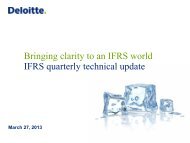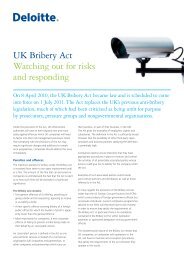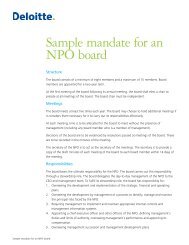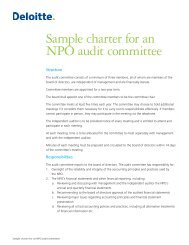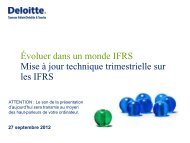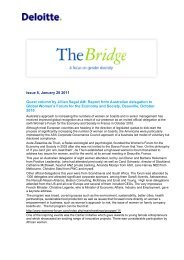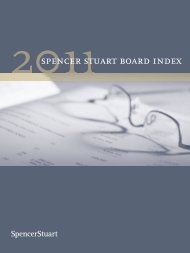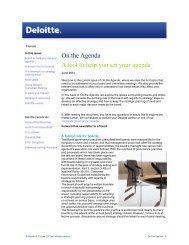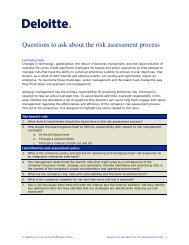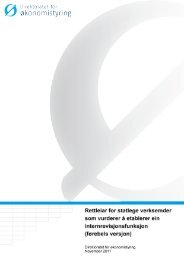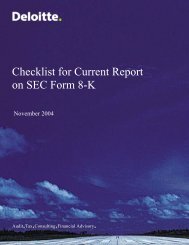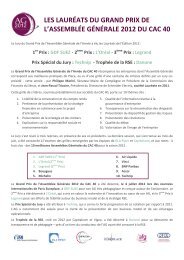Sample board performance evaluation form - Center for Corporate ...
Sample board performance evaluation form - Center for Corporate ...
Sample board performance evaluation form - Center for Corporate ...
You also want an ePaper? Increase the reach of your titles
YUMPU automatically turns print PDFs into web optimized ePapers that Google loves.
<strong>Sample</strong> <strong>board</strong> <strong>per<strong><strong>for</strong>m</strong>ance</strong><br />
<strong>evaluation</strong> <strong><strong>for</strong>m</strong>
The following questionnaire is based on emerging and leading practices to assist in the self-assessment of an individual<br />
director or the full <strong>board</strong>’s <strong>per<strong><strong>for</strong>m</strong>ance</strong>. It is not intended to be all-inclusive.<br />
When completing the <strong>per<strong><strong>for</strong>m</strong>ance</strong> <strong>evaluation</strong>, consider the following process:<br />
• Select a coordinator and establish a timeline <strong>for</strong> the process.<br />
• In addition to <strong>board</strong> members completing the <strong><strong>for</strong>m</strong> as a self-<strong>evaluation</strong>, ask individuals who interact with the <strong>board</strong><br />
members to provide feedback.<br />
• Ask each <strong>board</strong> member to complete an <strong>evaluation</strong> by selecting the appropriate rating that most closely reflects his/her<br />
<strong>per<strong><strong>for</strong>m</strong>ance</strong> and the <strong>board</strong>’s as a whole related to each practice.<br />
• Consolidate into a summarized document <strong>for</strong> discussion and review by the <strong>board</strong>.<br />
For each of the following statements, select a number between 1 and 5, with 1 indicating that you strongly disagree and<br />
5 indicating that you strongly agree with the statement. Select 0 if the point is not applicable or you do not have enough<br />
knowledge or in<strong><strong>for</strong>m</strong>ation to rank the organization’s <strong>board</strong> on a particular statement.<br />
<strong>Sample</strong> <strong>board</strong> <strong>per<strong><strong>for</strong>m</strong>ance</strong> <strong>evaluation</strong> <strong><strong>for</strong>m</strong>
Select the appropriate rating <strong>for</strong> each statement 0 1 2 3 4 5<br />
Composition and Quality<br />
Qualified <strong>board</strong> members are identified by sources independent of management<br />
(e.g., independent <strong>board</strong> members assisted by an independent firm in the search <strong>for</strong> candidates).<br />
Board members have the appropriate qualifications to meet the objectives of the <strong>board</strong>’s charter,<br />
including appropriate financial literacy.<br />
The <strong>board</strong> demonstrates integrity, credibility, trustworthiness, active participation, an ability to<br />
handle conflict constructively, strong interpersonal skills, and the willingness to address issues<br />
proactively.<br />
The <strong>board</strong> demonstrates appropriate industry knowledge and includes a diversity of experiences<br />
and backgrounds.<br />
Members of the <strong>board</strong> meet all applicable independence requirements.<br />
The <strong>board</strong> participates in a continuing education program to enhance its members’<br />
understanding of relevant risk, reporting, regulatory, and industry issues.<br />
The <strong>board</strong> monitors compliance with corporate governance regulations and guidelines.<br />
The <strong>board</strong> reviews its charter annually to determine whether its responsibilities are described<br />
adequately.<br />
New <strong>board</strong> members participate in an orientation program to educate them on the organization,<br />
their responsibilities, and the organization’s activities.<br />
The <strong>board</strong> chairman is an effective leader.<br />
The <strong>board</strong>, in conjunction with the nominating committee (or its equivalent), creates a<br />
succession and rotation plan <strong>for</strong> <strong>board</strong> members, including the <strong>board</strong> chairman.<br />
Legend<br />
<strong>Sample</strong> <strong>board</strong> <strong>per<strong><strong>for</strong>m</strong>ance</strong> <strong>evaluation</strong> <strong><strong>for</strong>m</strong><br />
0 Insufficient knowledge<br />
1 Strongly disagree<br />
5 Strongly agree
Select the appropriate rating <strong>for</strong> each statement 0 1 2 3 4 5<br />
Understanding the Business, including Risks<br />
The <strong>board</strong> takes into account significant risks that may directly or indirectly affect the<br />
organization. Examples include:<br />
• Regulatory and legal requirements<br />
• Concentrations (e.g., suppliers and customers)<br />
• Market and competitive trends<br />
• Financing and liquidity needs<br />
• Financial exposures<br />
• Business continuity<br />
• Organization reputation<br />
• Strategy execution<br />
• Management’s capabilities<br />
• Management override<br />
• Fraud control<br />
• Organization pressures, including “tone at the top”<br />
The <strong>board</strong> considers, understands, and approves the process implemented by management to<br />
effectively identify, assess, and respond to the organization’s key risks.<br />
The <strong>board</strong> understands and approves management’s fraud risk assessment and has an<br />
understanding of identified fraud risks.<br />
The <strong>board</strong> considers the organization’s <strong>per<strong><strong>for</strong>m</strong>ance</strong> versus that of its peers in a manner that<br />
enhances comprehensive risk oversight by using reports provided directly by management to the<br />
<strong>board</strong> or at the full <strong>board</strong> meeting. These may include benchmarking in<strong><strong>for</strong>m</strong>ation comparing<br />
the organization’s <strong>per<strong><strong>for</strong>m</strong>ance</strong> and ratios with industry and peers, industry trends, and budget<br />
analysis with explanations <strong>for</strong> areas where significant differences are apparent.<br />
Legend<br />
<strong>Sample</strong> <strong>board</strong> <strong>per<strong><strong>for</strong>m</strong>ance</strong> <strong>evaluation</strong> <strong><strong>for</strong>m</strong><br />
0 Insufficient knowledge<br />
1 Strongly disagree<br />
5 Strongly agree
Select the appropriate rating <strong>for</strong> each statement 0 1 2 3 4 5<br />
Process and Procedures<br />
The <strong>board</strong> develops a calendar that dedicates the appropriate time and resources needed to<br />
execute its responsibilities.<br />
Board meetings are conducted effectively, with sufficient time spent on significant or emerging.<br />
The level of communication between the <strong>board</strong> and relevant parties is appropriate; the<br />
<strong>board</strong> chairman encourages input on meeting agendas from committee and <strong>board</strong> members,<br />
management, the internal auditors, and the independent auditor.<br />
The agenda and related in<strong><strong>for</strong>m</strong>ation are circulated in advance of meetings to allow <strong>board</strong><br />
members sufficient time to study and understand the in<strong><strong>for</strong>m</strong>ation.<br />
Written materials provided to <strong>board</strong> members are relevant and concise.<br />
Meetings are held with enough frequency to fulfill the <strong>board</strong>’ s duties and at least quarterly,<br />
which should include periodic visits to organization locations with key members of management.<br />
The <strong>board</strong> maintains adequate minutes of each meeting.<br />
The <strong>board</strong> and the compensation committee regularly review management incentive plans to<br />
consider whether the incentive process is appropriate.<br />
The <strong>board</strong> meets periodically with the committee responsible <strong>for</strong> reviewing the organization’s<br />
disclosure procedures.<br />
The <strong>board</strong> respects the line between oversight and management.<br />
Board members come to meetings well prepared.<br />
Legend<br />
<strong>Sample</strong> <strong>board</strong> <strong>per<strong><strong>for</strong>m</strong>ance</strong> <strong>evaluation</strong> <strong><strong>for</strong>m</strong><br />
0 Insufficient knowledge<br />
1 Strongly disagree<br />
5 Strongly agree
Select the appropriate rating <strong>for</strong> each statement 0 1 2 3 4 5<br />
Oversight of the Financial Reporting Process, including Internal Controls<br />
The <strong>board</strong> considers the quality and appropriateness of financial accounting and reporting,<br />
including the transparency of disclosures.<br />
The <strong>board</strong> reviews the organization’s significant accounting policies.<br />
The <strong>board</strong> makes inquiries of the independent auditor, internal auditors, and management on<br />
the depth of experience and sufficiency of the organization’s accounting and finance staff.<br />
The <strong>board</strong> reviews the management recommendation letters written by the independent<br />
and internal auditors and monitors the process to determine that all significant matters are<br />
addressed.<br />
The <strong>board</strong> ensures that management takes action to achieve resolution when there are repeat<br />
comments from auditors, particularly those related to internal controls.<br />
Adjustments to the financial statements that resulted from the audit are reviewed by the audit<br />
committee, regardless of whether they were recorded by management.<br />
The <strong>board</strong> is consulted when management is seeking a second opinion on an accounting or<br />
auditing matter.<br />
Oversight of Audit Functions<br />
The <strong>board</strong> understands the coordination of work between the independent and internal auditors<br />
and clearly articulates its expectations of each.<br />
The <strong>board</strong> appropriately considers internal audit reports, management’s responses, and steps<br />
toward improvement.<br />
The <strong>board</strong> oversees the role of the independent auditor from selection to termination and has an<br />
effective process to evaluate the independent auditor’s qualifications and <strong>per<strong><strong>for</strong>m</strong>ance</strong>.<br />
The <strong>board</strong> considers the independent audit plan and provides recommendations.<br />
The <strong>board</strong> reviews the audit fees paid to the independent auditor.<br />
The <strong>board</strong> comprehensively reviews management’s representation letters to the independent<br />
auditor, including making inquiries about any difficulties in obtaining the representations.<br />
Legend<br />
<strong>Sample</strong> <strong>board</strong> <strong>per<strong><strong>for</strong>m</strong>ance</strong> <strong>evaluation</strong> <strong><strong>for</strong>m</strong><br />
0 Insufficient knowledge<br />
1 Strongly disagree<br />
5 Strongly agree
Select the appropriate rating <strong>for</strong> each statement 0 1 2 3 4 5<br />
Ethics and Compliance<br />
Board members oversee the process and are notified of communications received from<br />
governmental or regulatory agencies related to alleged violations or areas of non-compliance.<br />
The <strong>board</strong> oversees management’s procedures <strong>for</strong> en<strong>for</strong>cing the organization’s code of conduct.<br />
The <strong>board</strong> determines that there is a senior-level person designated to understand relevant legal<br />
and regulatory requirements.<br />
The <strong>board</strong> oversees the organization’s hotline or whistleblower process, reviews the log of<br />
incoming calls that relate to possible fraudulent activity, and understands the procedures to<br />
prohibit retaliation against whistleblowers.<br />
Monitoring Activities<br />
An annual <strong>per<strong><strong>for</strong>m</strong>ance</strong> <strong>evaluation</strong> of the <strong>board</strong> is conducted and any matters that require<br />
follow-up are resolved and presented to the full <strong>board</strong>.<br />
Overall <strong>evaluation</strong><br />
Use the space below to conclude on the overall results taking into account the quantitative results of this self-assessment<br />
and qualitative factors not considered above:<br />
Legend<br />
<strong>Sample</strong> <strong>board</strong> <strong>per<strong><strong>for</strong>m</strong>ance</strong> <strong>evaluation</strong> <strong><strong>for</strong>m</strong><br />
0 Insufficient knowledge<br />
1 Strongly disagree<br />
5 Strongly agree
www.corpgov.deloitte.ca<br />
Deloitte, one of Canada’s leading professional services firms, provides audit, tax, consulting and financial<br />
advisory services. Deloitte LLP, an Ontario limited liability partnership, is the Canadian member firm of Deloitte<br />
Touche Tohmatsu Limited. Deloitte operates in Quebec as Deloitte s.e.n.c.r.l., a Quebec limited<br />
Deloitte refers to one or more of Deloitte Touche Tohmatsu Limited, a UK private company limited by<br />
guarantee, and its network of member firms, each of which is a legally separate and independent entity.<br />
Please see www.deloitte.com/about <strong>for</strong> a detailed description of the legal structure of Deloitte Touche<br />
Tohmatsu Limited and its member firms.<br />
© 2013 Deloitte LLP<br />
Designed and produced by the Creative Design Studio in Montreal. 13-15



